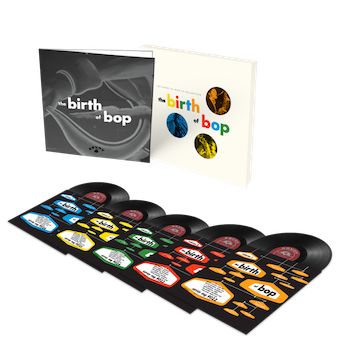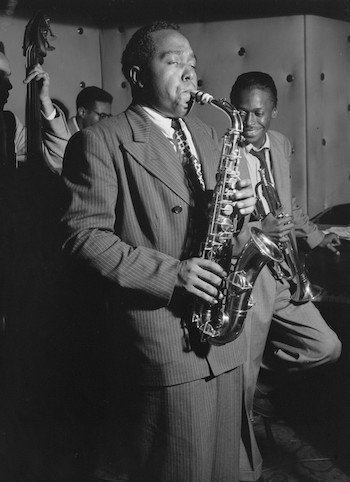Jazz Album Review: “The Birth of Bop” — Chronicling the Transition from Swing to Bop
By Steve Provizer
The Birth of Bop contains performances from some important participants in the bop revolution — Dexter Gordon, Stan Getz, Milt Jackson, Allen Eager, Fats Navarro, Max Roach, J.J. Johnson, and others.
The Birth of Bop: The Savoy 10-Inch LP Collection The music is being released in several formats, including a vinyl box set, featuring five 10-inch LPs, a 2-CD format on March 31, and digital editions now available.
 Funny how history interacts with aesthetics. The American Federation of Musicians (AFM) initiated a recording ban that, for most record companies, lasted from August 1942 to November 1944 (Decca and Capitol settled a year earlier and V discs continued to be made for distribution to the armed forces). With the major labels weakened, and record manufacturing capacity available on the cheap, a bunch of small indie labels arose — including Keynote, Dial, De Luxe, Continental, Guild, Apollo, and Savoy. These labels picked up some of the slack by cutting deals with the AFM, recording musicians incognito, and distributing only in major urban centers. Nonetheless, important musical ramifications followed from the strike.
Funny how history interacts with aesthetics. The American Federation of Musicians (AFM) initiated a recording ban that, for most record companies, lasted from August 1942 to November 1944 (Decca and Capitol settled a year earlier and V discs continued to be made for distribution to the armed forces). With the major labels weakened, and record manufacturing capacity available on the cheap, a bunch of small indie labels arose — including Keynote, Dial, De Luxe, Continental, Guild, Apollo, and Savoy. These labels picked up some of the slack by cutting deals with the AFM, recording musicians incognito, and distributing only in major urban centers. Nonetheless, important musical ramifications followed from the strike.
For one thing, major labels continued to be able to record without instrumentalists, drawing only on vocalists and vocal groups. This increasing emphasis on vocals was one of the factors that led to singers dominating the hit parade after the strike ended. Just as important was the fact that the first stages of bop or bebop, which was getting off the ground about 1940, was sparsely chronicled. We have some off-air radio checks and privately made tape recordings, but it wasn’t until 1944 that the first studio-produced bop recordings started to show up.
The indie jazz world was a bit of a free-for-all — not that the jazz recording world has ever been neat and tidy. In order to work as many sessions as possible, musicians moved from label to label, changing their names as necessary. Sometimes working groups recorded together, but just as often rhythm and horn sections were pulled together on the basis of who was available and at what price. This was how Savoy records operated.
Savoy was founded in 1942 by Herman Lubinsky, whose reputation for stinginess-cum-thievery was legendary. But the label’s prime mover was Teddy Reig, who had been a hustler in various underground trades for many years and was known as a person who knew people. In 1945, Lubinsky hired him to record jazz sessions for the label and almost all the tunes in this collection were supervised by Reig. The fact that he produced Charlie Parker’s first recording as a leader would be enough to assure him a place in the jazz A&R firmament.
None of those Charlie Parker sessions are on this album, although he is represented as a sideman on one 1944 Slim Gaillard date, “Romance Without Finance.” No doubt the reason for this is the release in 2002 of Charlie Parker, The Complete Savoy Studio Sessions. Also on the market are Classic Savoy Be-Bop Sessions 1945-49, The Savoy Story, Volume I, and The Savoy Jazz Collection. The Savoy archives are copious, but inevitably there’s overlap in all these releases. I haven’t gone through the track lists of them all, so I can’t chronicle exactly what’s doubled up. But I can say that the current collection, The Birth of Bop, contains performances from some important participants in the bop revolution — Dexter Gordon, Stan Getz, Milt Jackson, Allen Eager, Fats Navarro, Max Roach, J.J. Johnson, and others. Some you won’t find here are Dizzy Gillespie, Thelonius Monk, Miles Davis, Kenny Dorham, Charlie Christian, or Howard Mcghee.
Here are some random thoughts on this collection of tracks recorded on Savoy from 1944 to 1949:
I enjoyed hearing Milt Jackson, well represented on tracks from a 1949 session. His “Hearing Bells” is an especially pretty tune.
“Chase ‘N’ Lion (Chase’n The Lion),” from a 1948 Leo Parker session is interesting as a transitional tune; eight-to-the-bar boogie woogie-swing, but solos are bop-inflected. Parker plays baritone saxophone, Joe Newman, trumpet, Sir Charles Thompson, piano, and Al Lucas, bass.
Going from the chill of “Stan’s Mood” (Getz and co., 1949) to the relative mayhem of “Hollerin’ and Screamin’” (Eddie Lockjaw Davis & Fats Navarro, 1946) might not have been a choice I would have made as a programmer.
“Church Mouse” (Allen Eager, leader, 1947) shows that Doug Mettome needs more attention than he gets. He was a trumpet master.
Kai Winding’s version of Irving Berlin’s “Always” (1945) is slightly up-tempo. Did they think it would sound more “romantic” if they used so much reverb? Someone tinkered with this somewhere along the line. Winding is not quite up to JJ’s level at this point. He seems to “sit” on off notes — like flat 5’s — to show he’s hip to the new bop language.

Charlie Parker, Tommy Potter, Miles Davis, Dizzy Gillespie, and Max Roach, Three Deuces, New York. Photo: William P. Gottlieb
Don Byas is represented here on “Byas a Drink” (1945). This saxophonist was a “bridge” player in that he played with the heavier Coleman Hawkins sound but absorbed some of bop’s harmonic innovations.
Cecil Payne, usually a baritone player, sounds good on a rare alto sax appearance on “Jay Jay” (1946). J.J. Johnson himself is always pretty astounding on these tracks. Bud is clearly Bud, although his internal phrases are less involuted than they would become as the ’40s progressed.
“Long, Tall Dexter” (1946) is one of the tunes that Dexter Gordon built his early reputation on. His absorption of the tenor lineage is clear, as is his capacity to build a solo over several choruses. Although Leonard Gaskin is not quite in the top tier of trumpeters, he sounds good here — a nice sound and a concise statement.
“Little Benny” (1944) gives us a chance to hear Benny Harris, an influential trumpeter who died before his gifts blossomed fully. He shows a deeper understanding of the chord changes than most trumpeters did at this point. The track was originally issued under pianist Clyde Hart’s name. He was one of the most recorded swing-cum-bop pianists, well able to fill his slot, though not someone who left any imitators in his wake.
“BuBu,” from 1949, opens with an Afro-Latin flavor before going into swing for solos. Milt Jackson always sounds fresh on vibes. Walter Bishop, piano, Billy Mitchell on tenor, and Bill Massey, on trumpet, take nice turns. Julius Watkins still has a ways to go before he gets the testy French horn under control, as he eventually would.
“Don’t Worry About Me “(1946) was Getz’s first session as leader, age 18, which followed his abbreviated membership in Benny Goodman’s band. Getz shows that he already understood new ideas about harmony, but his tone is much weightier here — almost Coleman Hawkins-like. If his name were not listed in the personnel, it would be hard to recognize him.
On “Maternity” (1946), an Eddie Lockjaw Davis–led session, Huey Long, seldom recorded as guitar soloist, delivers an adequate turn. It’s always frustrating when Fats Navarro is limited to half a chorus. Davis carries most of the solo load, accenting the “jump” aspect of the tune.
“Donald Jay” (1947) is an early session for Allen Eager, with pianist Duke Jordan and Terry Gibbs on vibes.
Budd Johnson is the leader on 1944’s “Dee Dee’s Dance” and largely stays in his swing mode. Altoist Herbie Fields gets more space here: he takes a fairly schizophrenic solo, veering from Willie Smith (an early influence on Charlie Parker) to proto-bop. This is from the same session as “Little Benny” and, once again, we hear Benny Harris to advantage. The tempo is swift enough to force a few stumbles in several of the solos.
“Coppin the Bop” and “Junior” are other tracks from the 1946 J.J. Johnson session and there is a “Birth of the Cool” quality to these tunes and arrangements, albeit slightly less crowded, with an unorthodox solo order.

Serge Chaloff (lower left) with Georgie Auld, Red Rodney, and Tiny Kahn, c. August 1947. Photo by William P. Gottlieb
“Unmediated” is another from the Eager sessions from 1947 and the only change-up here is a George Wallington piano solo that lays it a lot more on the line — in a very Bud Powell fashion.
“Stealin’ Trash,” another from the Dec 1946 Eddie Lockjaw Davis session, shows us how the Texas Tenor and Honkin’ R&B sounds continued to play hide-and-seek with bop.
“Pete’s Beat” is the rare big band session, put together by Roy Porter in L.A. and recorded there in 1949. It has a Dizzy Gillespie big-band feel, featuring some folks who’d yet to appear in the East — Art Farmer, Jimmy Knepper, and Eric Dolphy. Dolphy briefly solos and is recognizable by his sound, if not his choice of notes, which is fairly conventional for the time.
“Pumpernickel” is a Serge Chaloff “sextette” from 1947. Chaloff wails, as does Red Rodney on trumpet.
The last tune on the set (1947) features “Morris Lane, the Tenor Saxsation.” Lane is a heavy blower who made his name in a Lionel Hampton aggregation. I’m not sure why this is the closer, given that it points to a vector that veered away from bop and led more directly toward the frenetic blowing of early Earl Bostic, Sam Butera, and Sam “The Man” Taylor.
Anyone owning this collection as well as Charlie Parker, The Complete Savoy Studio Sessions and Classic Savoy Be-Bop Sessions 1945-49 would have a pretty complete picture of the contribution Savoy records made to chronicling the transition from swing to bop.
Steve Provizer writes on a range of subjects, most often the arts. He is a musician and blogs about jazz here.

Fantastic overview, Steve. And the background on indie labels around the time of that ultimately self-defeating strike is especially useful. Just a heads up that this version of “Romance Without Finance” is credited to The Tiny Grimes Quintet, although Bird and Diz certainly did record with Slimorooney on other occasions.